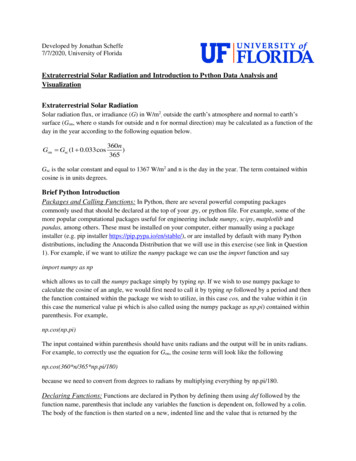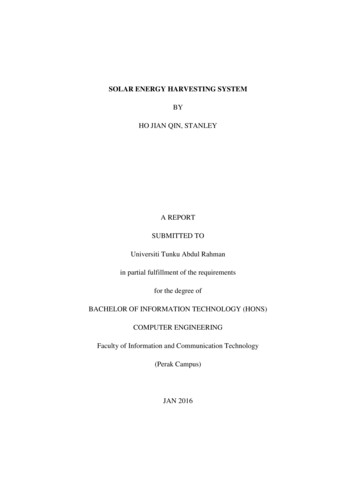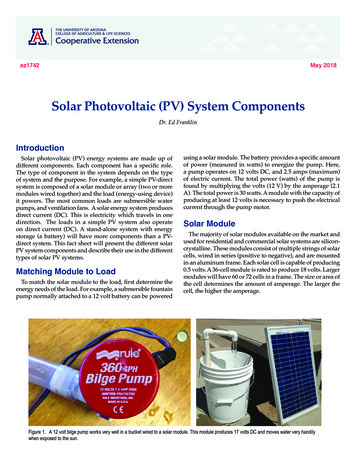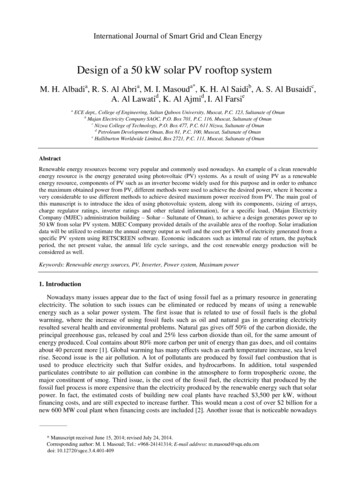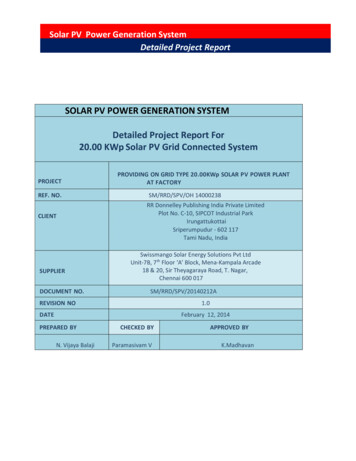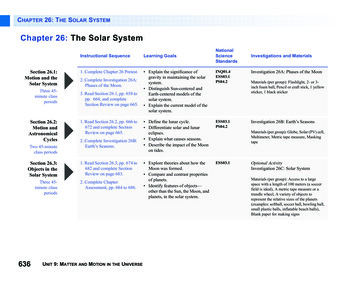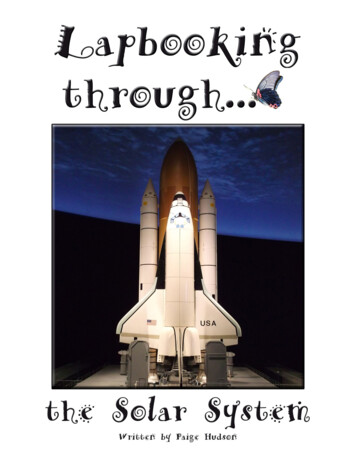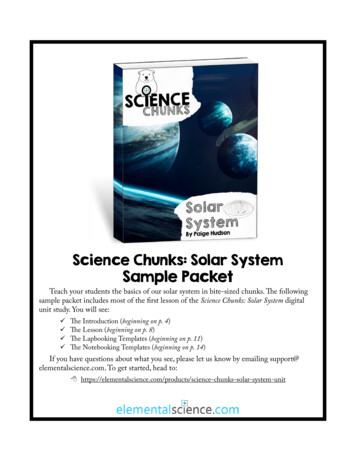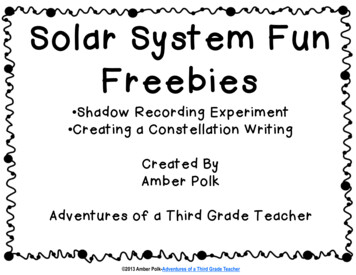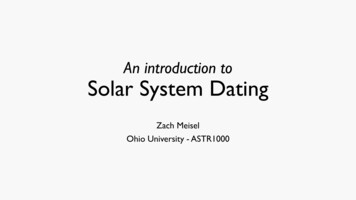
Transcription
An introduction toSolar System DatingZach MeiselOhio University - ASTR1000
“The solar system is 4.6 billion years old” how do we know that? Age determination in the solar system primarily consists of Radioactive dating Crater counting Comparing to other systems Computer modelsBeinahegut
Radioactive Decay Most nuclei undergo radioactive decay, which is aspontaneous transmutation into different isotope Each nucleus has a particular decay probability,which is constant, that determines the overallrate of decay for an ensemble of that nucleus.However, the decay of a single nucleus is random. This leads to the “universal decay law”, wherebythe abundance of an isolated sample of aradioactive nucleus will decay exponentially 𝑁𝑁 𝑡𝑡 𝑁𝑁(0)𝑒𝑒 λ𝑡𝑡 λ is the decay constant, which is related toln(2)the (more familiar) half-life via: λ 𝑡𝑡½ The half-life, 𝑡𝑡½ , is the time it takes for half ofthe sample to decay
Radiometric dating: basic conceptR. Taylor, Am. Sci. (2000) If I knew how much of a particular isotope was originally in a sample,then the current abundance could be used to determine the sampleage Example: Carbon-dating 14C (𝑡𝑡½ 5700 yr) is constantly replenished on Earth’s surfaceby cosmic ray spallation Living organisms have a constant intake of carbon, so the14C/12C ratio is constant.[Nuclear incidents and varying cosmic ray flux complicate this] Once the organism dies, there is no longer carbon uptake, so the14C decays away steadily 5700 years after an organism has died, the 14C/12C ratio is half ofthe original constant value. In general, time since death is: 14𝐶𝐶12𝐶𝐶 𝑡𝑡 𝑡𝑡 14𝐶𝐶12𝐶𝐶(0)𝑒𝑒 ln(2)𝑡𝑡/(5700 𝑦𝑦𝑦𝑦)14𝐶𝐶14𝐶𝐶5700 ln 12𝐶𝐶 𝑡𝑡 / 12𝐶𝐶 (0)ln(2)years After 10 half-lives, the ratio (1/1024) is difficult to measure,so other nuclear chronometers are neededThis is how we know theShroud of Turin is only from 1300AD(P.E.Damon et al. Nature 1989)
Radiometric dating: getting more advanced Often life is more complicated:We may not know the initial abundance of an isotope in asample and chemical effects may have changed theabundance (e.g. a gas escaping a rock) Instead focus on isotopic ratios, choosing a differentisotope of the same element as a reference, where thereference is stable and not fed by a long-lived decay Know that the sum of abundance along a decay chain(e.g. 87Rb 87Sr) is constant over time:𝑁𝑁1 𝑡𝑡 𝑁𝑁2 (𝑡𝑡)𝑁𝑁𝑠𝑠 Since 𝑁𝑁1 0 𝑁𝑁1 0 𝑁𝑁2 (0)𝑁𝑁𝑠𝑠𝑁𝑁 (𝑡𝑡)𝑁𝑁1 (𝑡𝑡)𝑒𝑒 λ1𝑡𝑡 , 2𝑁𝑁𝑠𝑠 𝑁𝑁2 0 𝑁𝑁1 (𝑡𝑡)(1 𝑒𝑒 λ1 𝑡𝑡 )𝑁𝑁𝑠𝑠 This is an equation for a line, 𝑦𝑦 𝑚𝑚𝑚𝑚 𝑏𝑏, where the slope𝑁𝑁 (0)𝑚𝑚 (1 𝑒𝑒 λ1 𝑡𝑡 ) and the y-intercept 𝑏𝑏 2𝑁𝑁𝑠𝑠 Since we know the decay constant of 87Rb λ1 , the slope ofthese ratios for many meteoritic samples gives the age, 𝑡𝑡G. Wetherill, Ann. Rev. Nuc. Sci. (1975)
Radiometric dating from meteorites give a consistent picture,the solar system is 4.56 Gyr oldDebaille et al. Earth Plan. Sci Lett. 2017G. Wetherill, Ann. Rev. Nuc. Sci. (1975)Why meteorites? No geology. On Earth, you have to be sure you’regetting the oldest rock and not just the oldest rock you can find
Assuming a constant rate of impacts on aplanet or moon, the number of craters withinan area should be directly related to thesurface age For instance, an area with fewer craters mayhave had more recent volcanic activity,resulting in a fresher surface However, the rate of bombardment isn’tnecessarily constant. Radiometric dating has helped make cratercounting an absolute measurement of ages Crater-counting still has the issue ofsecondary craters resulting in double-counting,so craters need to be carefully examined. Crater erosion is an issue on objects withweatherFortezzo, Spudis & Harrel (USGS)D. Hughes MNRAS 2000Crater counting, for relative ages
Comparison to other systems, for early historyFor young stellar systems, we can use a star’s position on the HR-diagram for the age,and use this to determine the timescale for planet formation (See Intro to Planet Formation)NASA/ESA, L. Ricci (ESO))
Comparison to modelsSimulations can offer possible explanations for how the solar system got to be how it is but one issue is that the solar system is “chaotic”. E.g. perturbing Mercury’s initial position by 1mmresults I largely different eccentricity. The “solution” is that lots of model calculationsneed to be run in order to develop a probabilisticpicture of the solar systemHal Levison (SwRI)
Radiometric dating has helped make crater counting an absolute measurement of ages Crater-counting still has the issue of secondary craters resulting in double-counting, so craters need to be carefully examined. Crater erosion is an issue on objects with weather. Fortezzo, Spudis & Harrel (USGS) D. Hughes MNRAS 2000

